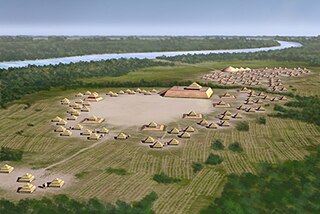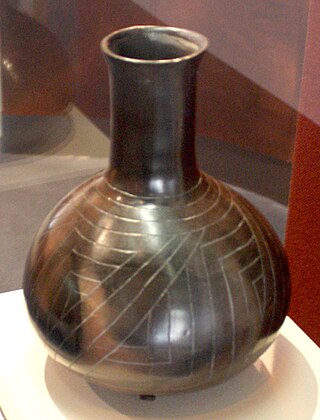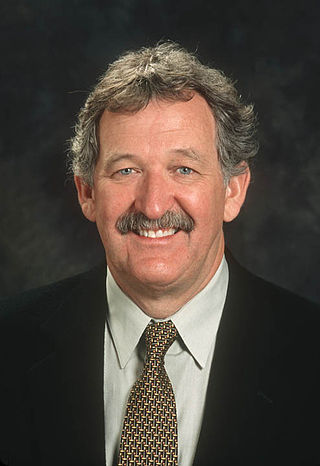
Anthropology is the scientific study of humanity, concerned with human behavior, human biology, cultures, societies, and linguistics, in both the present and past, including past human species. Social anthropology studies patterns of behavior, while cultural anthropology studies cultural meaning, including norms and values. A portmanteau term sociocultural anthropology is commonly used today. Linguistic anthropology studies how language influences social life. Biological or physical anthropology studies the biological development of humans.

The National Museum of Natural History is a natural history museum administered by the Smithsonian Institution, located on the National Mall in Washington, D.C., United States. It has free admission and is open 364 days a year. In 2022, with 3.9 million visitors, it was the most-visited museum in the United States.
Environmental archaeology is a sub-field of archaeology which emerged in 1970s and is the science of reconstructing the relationships between past societies and the environments they lived in. The field represents an archaeological-palaeoecological approach to studying the palaeoenvironment through the methods of human palaeoecology. Reconstructing past environments and past peoples' relationships and interactions with the landscapes they inhabited provides archaeologists with insights into the origin and evolution of anthropogenic environments, and prehistoric adaptations and economic practices.

Material culture is the aspect of culture manifested by the physical objects and architecture of a society. The term is primarily used in archaeology and anthropology, but is also of interest to sociology, geography and history. The field considers artifacts in relation to their specific cultural and historic contexts, communities and belief systems. It includes the usage, consumption, creation and trade of objects as well as the behaviors, norms and rituals that the objects create or take part in.

The Bureau of American Ethnology was established in 1879 by an act of Congress for the purpose of transferring archives, records and materials relating to the Indians of North America from the Interior Department to the Smithsonian Institution. But from the start, the bureau's visionary founding director, John Wesley Powell, promoted a broader mission: "to organize anthropologic research in America." Under Powell, the bureau organized research-intensive multi-year projects; sponsored ethnographic, archaeological and linguistic field research; initiated publications series ; and promoted the fledgling discipline of anthropology. It prepared exhibits for expositions and collected anthropological artifacts for the Smithsonian United States National Museum. In addition, the BAE was the official repository of documents concerning American Indians collected by the various US geological surveys, especially the Geographical and Geological Survey of the Rocky Mountain Region and the Geological Survey of the Territories. It developed a manuscript repository, library and illustrations section that included photographic work and the collection of photographs.
Robert E. Bell, was an archaeologist. He was a Professor of Anthropology at the University of Oklahoma from 1947-1980, and Curator of Archaeology at the Stovall Museum of Science and History at the University of Oklahoma. He pioneered work on the Spiro Mounds archaeological site in eastern Oklahoma.

Spiro Mounds is an Indigenous archaeological site located in present-day eastern Oklahoma. The site was built by people from the Arkansas Valley Caddoan culture. that remains from an American Indian culture that was part of the major northern Caddoan Mississippian culture. The 80-acre site is located within a floodplain on the southern side of the Arkansas River. The modern town of Spiro developed approximately seven miles to the south.

The Tuxtla Statuette is a small 6.3 inch (16 cm) rounded greenstone figurine, carved to resemble a squat, bullet-shaped human with a duck-like bill and wings. Most researchers believe the statuette represents a shaman wearing a bird mask and bird cloak. It is incised with 75 glyphs of the Epi-Olmec or Isthmian script, one of the few extant examples of this very early Mesoamerican writing system.
Biraja Sankar Guha was an Indian physical anthropologist, who classified Indian people into races around the early part of the 20th century and he was also a pioneer to popularize his scientific ideas in the vernacular. He was the first Director of the Anthropological Survey of India (ASI) (1945–1954).
Dennis J. Stanford was an archaeologist and Director of the Paleoindian/Paleoecology Program at the National Museum of Natural History at the Smithsonian Institution.
The following outline is provided as an overview of and topical guide to anthropology:

The National Anthropological Archives is the third largest archive in the Smithsonian Institution and a sister archive to the Human Studies Film Archive. The collection documents the history of anthropology and the world's peoples and cultures, and is used in indigenous language revitalization. It is located in the Smithsonian's Museum Support Center in Suitland, Maryland, and is part of the Department of Anthropology at the National Museum of Natural History.
Sugarscape is a model for artificially intelligent agent-based social simulation following some or all rules presented by Joshua M. Epstein & Robert Axtell in their book Growing Artificial Societies.

Museum anthropology is a domain of scholarship and professional practice in the discipline of anthropology.

The Etowah plates, including the Rogan Plates, are a collection of Mississippian copper plates discovered in Mound C at the Etowah Indian Mounds near Cartersville, Georgia. Many of the plates display iconography that archaeologists have classified as part of the Southeastern Ceremonial Complex (S.E.C.C.), specifically "Birdman" imagery associated with warriors and the priestly elite. The plates are a combination of foreign imports and local items manufactured in emulation of the imported style. The designs of the Rogan plates are in the Classic Braden style from the American Bottom area. It is generally thought that some of the plates were manufactured at Cahokia before ending up at sites in the Southeast.

Jereldine "Jeri" Redcorn is an Oklahoman artist who single-handedly revived traditional Caddo pottery.

William Wyvill Fitzhugh IV is an American archaeologist and anthropologist who directs the Smithsonian’s Arctic Studies Center and is a Senior Scientist at the National Museum of Natural History. He has conducted archaeological research throughout the circumpolar region investigating cultural responses to climate and environmental change and European contact. He has published numerous books and more than 150 journal articles, and has produced large international exhibitions and popular films. Of particular note are the many exhibition catalogues he has had edited, which make syntheses of scholarly research on these subjects available to visitors to public exhibitions.
Computational social science is the academic sub-discipline concerned with computational approaches to the social sciences. This means that computers are used to model, simulate, and analyze social phenomena. Fields include computational economics, computational sociology, cliodynamics, culturomics, nonprofit studies, and the automated analysis of contents, in social and traditional media. It focuses on investigating social and behavioral relationships and interactions through social simulation, modeling, network analysis, and media analysis.

Bruce D. Smith is an American archaeologist and curator at the Smithsonian Institution's National Museum of Natural History who primarily focuses on the interaction of humans with their environment, especially the origins of agriculture in eastern North America agricultural complex.

Mildred Mott Wedel was an American scholar of Great Plains archaeology and ethnohistory. She was one of the first professionally trained female archaeologists and was distinguished in her field. Many of her publications were about the Siouan people, and wrote several important articles on French exploration in the Central and Southern Plains.











